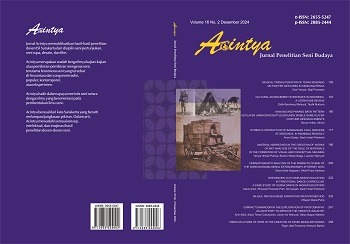NA SAJI, NEW BALINESE KARAWITAN CREATION METHOD
DOI:
https://doi.org/10.33153/acy.v16i2.6765Keywords:
Na Saji, Creation Method, Karawitan BaliAbstract
Balinese karawitan composing basically uses intuition and accumulated artistic experience to create new karawitan music. The way the composer works is by transferring the musical abstraction stored in the brain memory to the musicians in an imitative way. In addition to having artistic experience, Balinese composers must also have the intellect to create Balinese musical works. The composer's intellect can then give rise to a new Balinese musical creation methodology as a refinement of the previous Balinese musical creation methodology. The refinement of Balinese musical creation methodology also aims to create a direction or projection of Balinese musical creation that is more educational than a performance. Refinement by developing the methodology of previous karawitan composers such as I Wayan Beratha, I Nyoman Windha and Pande Made Sukerta as objects of study and comparison. After reviewing and comparing the three stages of composers, it was deemed necessary to refine the stages of reading, discussion and writing. This resulted in the creation of a new musical methodology called Na Saji. Na Saji is a newly initiated methodology for creating Balinese karawitan music. The methodology of creating Balinese karawitan music is called Na Saji. The name of the Na Saji method is taken from the first letter of each stage, the letter ‘N’, which in Balinese script reads ‘Na’. While saji refers to the meaning of serving or presentation. So Na Saji is a method for presenting the stages of creating Balinese gamelan works. The five stages of the Na Saji method are: nyelehin (observing), nureksin ( analyzing), nyurat (writing), ngendingin (singing) and nabuhang (playing). The abstract should be in one paragraph.The font is Cambria, 10 pt, italic, and justify. Abstract is in 200-250 words, which is followed by 3-5 keywords.The abstract should succinctly describes your entire paper. It comprises of the purposes of the research, method, and the findings of the research, Novelty.
Downloads
References
Alfari, S. (2022). Mengenal Arsitektur Neo Klasik. Arsitag.Com.
Ardana, I. K. (2017). Metode Penciptaan Karya-Karya Baru Karawitan Bali. In Karya Cipta Seni Pertunjukan.
Atmojo, R. B. S., Marsudi, M., & Jatilinuar, S. R. K. (2022). PRIYANGGA: Sebuah Komposisi Karawitan dalam Perspektif Personal. Resital: Jurnal Seni Pertunjukan. https://doi.org/10.24821/resital.v23i3.6405
Daniswara, I. P. (2023). Megineman Sebuah Komposisi Karawitan Kreasi Baru. GHURNITA: Jurnal Seni Karawitan. https://doi.org/10.59997/jurnalsenikarawitan.v1i2.335
Djohan. (2021). Adiwarna Suka Hardjana, Cermin Intelektual Musik (Djohan (ed.); 1st ed.). Akal Budi Media.
Granoka, I. W. O. (2007). Reinkarnasi Budaya (1st ed.).
Hardjana, S. (2004). Esai & Krtitik Musik (S. Dema (ed.); 1st ed.). Galang Press.
I Komang, R. sunadi, & Suharta, I. W. (2023). Nguci a New Musical Creations | Musik Kreasi Baru Nguci. GHURNITA: Jurnal Seni Karawitan. https://doi.org/10.59997/jurnalsenikarawitan.v3i2.2155
Kariasa, I. N., & Putra, I. W. D. (2021). Karya Karawitan Baru Manikam Nusantara. Mudra Jurnal Seni Budaya. https://doi.org/10.31091/mudra.v36i2.1471
Rustopo. (2010). Gamelan Kontemporer di Surakarta (1st ed.). ISI Press Solo.
Setiaji, D. (2021). MODEL KOMPOSISI MUSIK TERAPI RELAKSASI UNTUK IBU HAMIL BERBASIS IDIOM MUSIKAL KARAWITAN. Acintya : Jurnal Penelitian Seni Budaya, 13(1), 15–27. https://doi.org/10.33153/acy.v13i1.3818
Sudirana, I. W. (2020). Answering Questions, Questioning Answers: Understanding Tradisi and Moderen in the Intellectual Process of Balinese New Music Creations. Malaysian Journal Of Music, 9, 1–16. https://doi.org/10.37134/mjm.vol9.1.2020
Sudirana, I. W. & I. W. D. P. (2021). Telaah Lontar Prakempa dan Aji Gurnita Sebagai Metode Penciptaan Gending-Gending Neo-Klasik.
Supanggah, R. (2011). Dunia Pewayangan di Hati Seorang Pengrawit (1st ed.). ISI Press Solo.
Sustiawati, N. L., Surya Negara, I. G. O., Sumarno, R., & Nalan, A. S. (2020). Merangkai Nusantara Melalui Seni Wadantara. Mudra Jurnal Seni Budaya. https://doi.org/10.31091/mudra.v35i2.1063
Tenzer, J. R. & M. (2020). Identitas & Genre Dalam Gamelan Gong Kebyar (I. W. Sudirana (ed.); 1st ed.). Art Music Today.
Widiantara, I. N. Y. P., Santosa, H., & Suartaya, K. (2020). Proses Penciptaan Komposisi Karawitan Kreasi Baru Paras Paros. PROMUSIKA. https://doi.org/10.24821/promusika.v1i1.3607
Yadnya Yusana, I. P. P., & Hartini, N. P. (2023). Creative Percussion “Ilang” | Tabuh Kreasi “Ilang.” GHURNITA: Jurnal Seni Karawitan. https://doi.org/10.59997/jurnalsenikarawitan.v3i3.1673
Downloads
Published
How to Cite
Issue
Section
License
Copyright (c) 2025 I Wayan Diana Putra

This work is licensed under a Creative Commons Attribution 4.0 International License.
Author continues to retain the copyright if the article is published in this journal. The publisher will only need publishing rights




